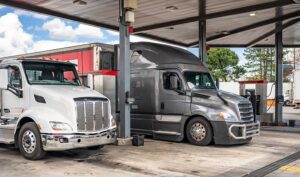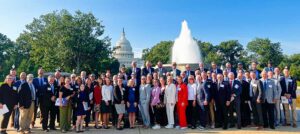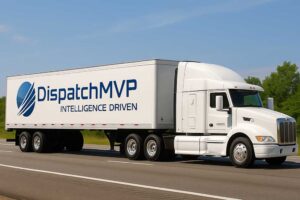Now that the bipartisan $1 trillion infrastructure bill has been signed into law by President Joe Biden, many in the trucking industry are asking, “What’s in it for us?”
The U.S. Department of Transportation (DOT) has released state-by-state fact sheets that highlight how funds will be spent.
And while the trucking industry will certainly benefit from the dozens of new roads and bridges that will be constructed, along with repairs to older ones, there’s only one trucking-specific item laid out in the new law.
It provides for an apprenticeship program for commercial drivers between the ages of 18 and 21. At the end of the program, certain drivers in that age group will be allowed to travel and deliver goods across the nation. Currently, these drivers are limited to driving within state lines. Full details about the program have yet to be released.
As for one of the biggest issues facing the trucking industry — a serious deficit of safe parking spaces — there’s no mention of it at all.
And that’s disappointing to industry leaders like Mark Walker, chairman and CEO of Missouri-based TransLand.
“As one of the Top 5 industry-rated challenges voiced by professional drivers in the recent ATRI study, and an issue that has been Top 10 on company and truckers’ minds for years, it is more than disappointing that specific funds were not earmarked to meet this problem,” Walker said. “It’s unbelievable.”
Overall, however, Walker said he is satisfied with the bill.
“It means jobs,” he said. “It means improved efficiencies in trucking company operations, better driving conditions for professional drivers, and a reduction in bottlenecks that plague our industry.
“Perhaps most importantly, it means improved safety on our nation’s highways for all that use the highway system, whether it’s to move freight or visit loved ones,” he noted.
As for the future, Walker said Congress must keep tackling the critical supply chain issues facing the nation.
It can do that by “creating incentives and removing roadblocks to our transportation system,” he said.
“Let’s expedite allowing 18- to 21-year-olds to drive interstate, with proper training and coaching,” he stated, continuing, “I’d like to see additional investment in workforce development that targets transportation industry jobs, especially professional drivers and technicians.
“I think we’ll need additional safeguards to protect the owner/operator system to allow it to thrive,” he added. “I believe Congress needs to create more work VISAs for immigrant workers that can meet our short-term and long-term capacity issues. Many other industries have thrived with this model. Trucking can too.”
For now, government officials are focusing on how the influx of cash will create jobs, make America more environmentally friendly, and improve quality of life.
“Americans rely on our transportation infrastructure every day — to get to work, school, loved ones, and to move goods across our economy,” said DOT Secretary Pete Buttigieg.
“The once-in-a-generation investments in the Bipartisan Infrastructure Law will improve people’s lives in every state in the nation by increasing access to safe, clean, reliable transportation,” he shared.
Looking at the DOT’s state fact sheets (available here), it’s easy to see how much the improvement money is needed.
In California, there are 1,536 bridges and more than 14,220 miles of highway in poor condition, according to the DOT. Since 2011, commute times have increased by 14.6% in the Golden State, and on average, each driver pays $799 per year in costs due to driving on roads in need of repair.
Based on formula funding alone, California would expect to receive approximately $29.5 billion over five years in federal highway formula funding for highways and bridges. On an average annual basis, this is about 44.1% more than the state’s federal-aid highway formula funding under current law.
California can also compete for the $12.5 billion Bridge Investment Program for economically significant bridges and $15 billion of national funding in the law dedicated to megaprojects, which will deliver substantial economic benefits to communities.
Additionally, California can expect to receive approximately $555 million over five years in formula funding to reduce transportation-related emissions, as well as about $631 million over five years to increase the resilience of its transportation system.
In Pennsylvania, there are 3,353 bridges and more than 7,540 miles of highway in poor condition, according to the DOT.
Since 2011, commute times have increased by 7.6% in Pennsylvania, and on average, each driver pays $620 per year in costs due to driving on roads in need of repair.
Based on formula funding, Pennsylvania would expect to receive approximately $13 billion over five years in federal highway formula funding for highways and bridges. On an average annual basis, this is about 40.4% more than the state’s federal-aid highway formula funding under current law.
Just as in California and all other states, Pennsylvania can compete for the Bridge Investment Program and megaproject funds.
Pennsylvania can expect to receive approximately $265 million over five years in formula funding to reduce transportation-related emissions, in addition to about $301 million over five years to increase the resilience of its transportation system.
During a recent New Hampshire stop, Biden said there were 215 bridges deemed “structurally unsafe” and 700 miles of highway in that state listed in poor condition, which he said costs residents heavily each year in gas and repairs.
In addition to speeding repairs to roads and bridges, Biden touted the law’s investments in upgrading public transit and trains, replacing lead pipes and expanding access to broadband internet.
The law, Biden said, is estimated to create an extra 2 million jobs a year, and he insisted it also would improve supply chain bottlenecks that have contributed to rising prices for consumers by providing funding for America’s ports, airports and freight rail.
“This isn’t esoteric, this isn’t some gigantic bill — it is, but it’s about what happens to ordinary people,” the president said. “Conversations around those kitchen tables that are both profound as they are ordinary: How do I cross the bridge in a snowstorm?”
Linda Garner-Bunch has been with The Trucker since 2020, picking up the reins as managing editor in 2022. Linda has nearly 40 years of experience in the publishing industry, covering topics from the trucking and automotive industry to employment, real estate, home decor, crafts, cooking, weddings, high school sports — you name it, she’s written about it. She is also an experienced photographer, designer and copy editor who has a heartfelt love for the trucking industry, from the driver’s seat to the C-suite.















